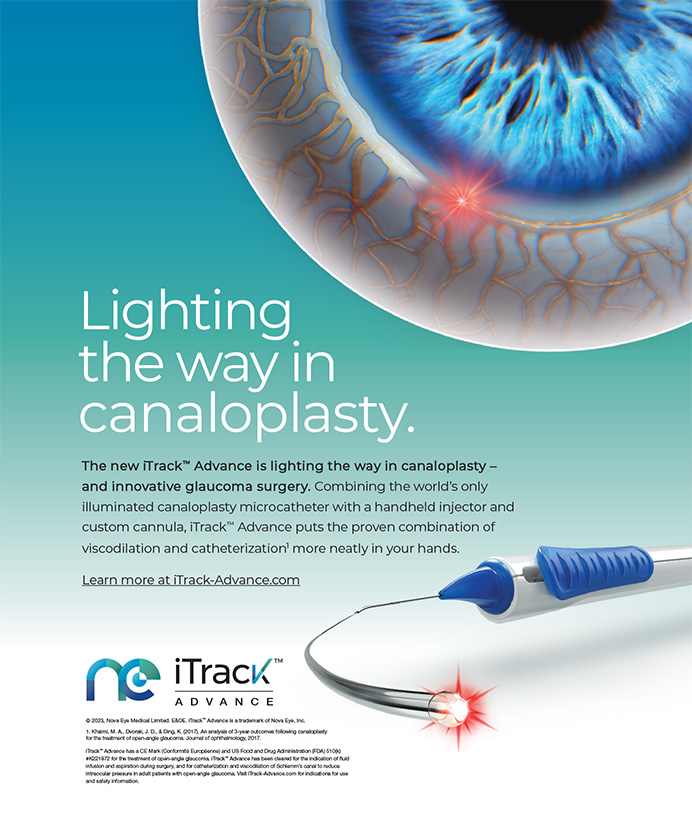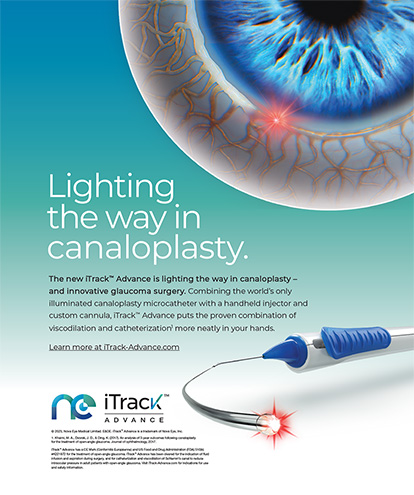When I undertook developing a light-adjustable IOL, the challenge lay in creating a new lens material that would permit fine-tuning with safe levels of irradiation. After a few unsuccessful consultations at the University of California, Berkeley, and Stanford University, I had the good fortune to meet with Robert Grubbs, PhD, and Julia Kornfield, PhD, both from the California Institute of Technology. They conceived an approach to engineering this technology based on the principles underlying holography, and we began working on the lens in 1996. Once we developed a functional lens material, we founded Calhoun Vision, Inc. (Pasadena, CA).
With the Light Adjustable Lens (LAL), surgeons will be able to achieve much more accurate outcomes, because they will be able to modify the IOL's power postoperatively.
HOW THE LENS WORKS
The LAL consists of a silicone matrix into which smaller, photosensitive molecules are embedded. Shining a light onto the center of the lens polymerizes the photosensitive molecules, which creates a concentration gradient between the irradiated region (where the photosensitive silicone molecules polymerized) and unirradiated regions (where these molecules persist) (Figure 1). Over a 12-hour period, the photosensitive molecules migrate from the untreated areas, down the concentration gradient, and into the irradiated region depleted of these molecules. This movement causes the irradiated region to swell and thereby increases the lens power. If instead we treat the edges of the lens, the photosensitive molecules will migrate outward from the central, untreated region, which will flatten the center of the lens and reduce its dioptric power (Figure 2). Treatment may also be directed along a specific meridian of the lens in order to correct astigmatic errors.
The amount of energy applied to the LAL determines the degree to which the lens power changes. This dose response is highly tunable; in vitro studies we have conducted demonstrate that power adjustments to within less than 0.25 D are highly reproducible. One day after the power adjustment, the patient returns so that we may confirm that the lens has the desired power. If it does, we irradiate the entire lens, which polymerizes all of the remaining photosensitive silicone molecules. After this lock-in step, the LAL is essentially a standard silicone IOL. Before this step, the LAL can be readjusted, a fact that will make it possible for the patient to try monovision or multifocality and then have that modality removed if it proves undesirable.
RISK ASSESSMENT
The amount of light used to modify the lens power is within the guidelines set by the American National Safety Institute. Nick Mamalis, MD, at the Moran Eye Center in Salt Lake City has conducted studies to evaluate the LAL's biocompatibility in a rabbit model. His 3-month results reveal excellent biocompatibility comparable to that found in control eyes implanted with a commercially available silicone IOL. I anticipate beginning human trials early this year. Arturo Chayet, MD, of Tijuana, Mexico, will conduct the initial clinical studies in which a limited number of the IOLs will be implanted in legally blind human eyes in order to confirm their safety, biocompatibility, and adjustability in humans. Following successful results in these patients, we will implant the LAL in sighted eyes. Depending on those results, we will submit an application to the FDA for an Investigational Device Exemption.
WHERE WE ARE HEADING
We would like to develop an acrylic version of the LAL and also an injectable LAL that could fill the capsular bag and thereby restore accommodation. This accommodating lens would allow surgeons to correct any postoperative refractive errors in order to achieve emmetropia at near and distance. Preliminary work on the injectable LAL has demonstrated the feasibility of this approach.
Our current light delivery system is an analog device that will be used to correct myopia, hyperopia, and toric errors. We are working collaboratively with Carl Zeiss Meditec Inc. (Jena, Germany) to develop a digital light delivery system that will correct higher-order aberrations in the LAL. We have already corrected higher-order aberrations in vitro with this digital system. For example, we placed a tetrafoil spatial intensity pattern on one of our lenses and found that the device faithfully recorded the digital output of this pattern onto the LAL.
Regarding aberration correction, contrast sensitivity is another issue that has assumed increasing importance. By attempting to restore higher levels of contrast sensitivity to patients, the Tecnis lens (Pharmacia Corporation, Peapack, NJ) represents a step in the right direction. This IOL has negative spherical aberrations at its margins. We can create similar asphericity in the LAL in situ, which is a distinct advantage. Decentration or implanting an incorrectly powered Tecnis lens would compromise its efficacy in terms of contrast sensitivity and refractive correction. We can implant a spherical lens into the eye, adjust its power to render the patient emmetropic (including any astigmatic error), and introduce the negative spherical aberration at the IOL's margins.
Daniel M. Schwartz, MD, is Associate Professor of Ophthalmology and Director of the Retina Service at the University of California, San Francisco. He is Chairman of the Board for and a stockholder in Calhoun Vision, Inc. Dr. Schwartz may be reached at (415) 476-1887; schwartz7@mindspring.com.


